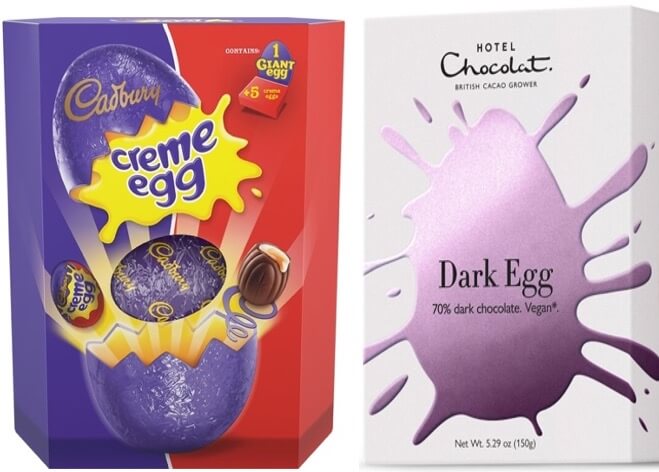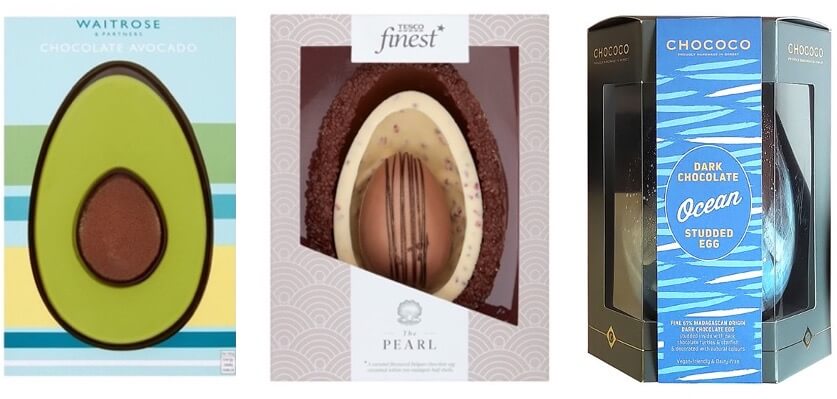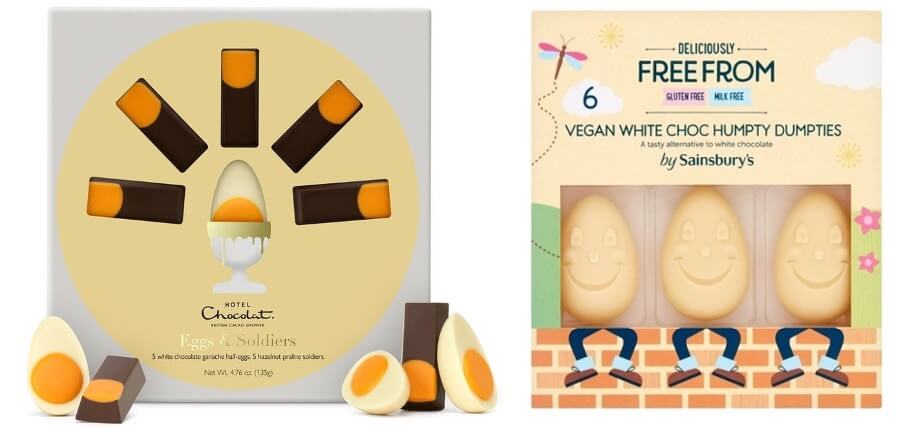Our Thoughts
A Taste of Comfort Chocolate Easter Eggs
Spring has finally arrived, with its main celebration, Easter, just around the corner. While we may not be able to freely immerse ourselves in Easter celebrations, given that we are in the midst of the global Covid-19 pandemic, participating in some popular rituals of the season, like indulging in chocolate Easter eggs, can provide a small, but welcome reprieve from our current reality. Since ancient times, eggs have been a symbol of birth, growth and renewal. These meanings are also infused in chocolate eggs, a popular British Easter treat for children since 1875. Given the popular association of chocolate as an indulgent treat together with these traditional associations, chocolate eggs can provide emotional comfort in uncertain times.
While the eggs themselves communicate these values, so do their packaging. Chocolate egg packaging can communicate additional values of nostalgia and playfulness that are increasingly relevant to the millennial generation. Playfulness offers temporary ease and escape from daily stresses. While nostalgia for simpler times experienced in youth provides solace and emotional comfort in the midst of uncertainty. Both reflect pre-existing anxieties around job security, homeownership and financial fragility that underpin millennials’ lives. Increasingly, food and beverage brands are appealing to these consumer’s values through their packaging to gain a competitive advantage.
Chocolate eggs are no different. While typically categorised as a child food product, more brands are revisiting these childhood treats and tailoring both products and packaging for this older demographic. As these consumers are increasingly looking to brands for emotional comfort, some insight can be found in current Easter egg packaging.
Youthful Playfulness
Cadbury’s Creme Egg and Hotel Chocolat’s Vegan egg packaging communicate playfulness through their use of splash or splat designs, reminiscent of the Nickelodeon kids’ channel or Art Attack logo. This imagery communicates to consumers that they can engage in messy, carefree enjoyment, with license to ‘play’ with their food. Looking more closely at Cadbury’s livery, we can see that their Red and Yellow primary colours connote kid friendly brands, like McDonald’s. Their sunburst pattern along with imagery of mini eggs springing outward from the base of the broken egg, connotes energetic release. Together, this codes Easter eggs as also a source of youthful energetic fun encapsulated in every bite. However, youth is also combined with adult taste, as its deep purple livery and cursive typeface cues traditional luxury and elegance. Unlike Cadbury’s bright primary colours and deep purple, Hotel Chocolat’s tertiary metallic purple shade with a slightly raised texture connotes the nuanced complexity and multisensorial experience of emergent premium products for adults. Their splat image set on a pared back white background, connotes ‘messy minimalist’ art design known for its display of simultaneous chaos and control. This amalgamation appeals to a sophisticated ‘adult’ playfulness in the target demographic.

Natural Renewal and Calm
What is particularly noticeable about how emergent Easter packaging signals comfort – particularly renewal and calmness, is through an unexpected and sophisticated reinvention of what an Easter ‘egg’ can be. For instance, Waitrose’s ‘avocado’ chocolate egg still captures the newness and naturalness of spring in the light green livery egg, signalling sprouting vegetation and a ripening freshness. Its soft pastel palette alludes to spring colours often found in a familiar and accessible natural environment (e.g. plants, sun and soil). Furthermore, the mimicry of an avocado seed suggests the beginning of life, similar to an animal-based egg. Yet, by tapping into millennial’s fixation with avocados, Waitrose appears modern and culturally relevant, as they update tradition through a similarly oval shaped, yet unconventional food object in the context of Easter.
Similarly, Tesco’s Finest ‘The Pearl’ pack’s use of an untraditional food object – an Oyster – that bears similarities to an oval shaped egg, brings originality to a formulaic style. Additionally, the focus on more ‘remote’ nature represented in oceanic motifs in both Tesco’s and Chococo’s pack designs, appears to appeal to millennial’s increasing dissociation from established religions to spirituality/mindfulness practices. For example, the repetitive patterns of the curved lines on the Tesco pack, resemble ocean waves mimicking cyclical natural movement, and recalls popular yoga or meditative brands designs. Chococo’s blue colour schemes with imagery resembling light reflecting off ‘ocean’ waves connotes tranquillity in the midst of vastness. The theme of calmness is also seen in Tesco’s design, from the solitary line drawn imagery of the open oyster revealing its pearl, surrounded by waves. This combination codes chocolate eggs as a modern, creative source of serenity and renewal.

Refined Nostalgic Comfort
Hotel Chocolat’s Eggs & Soldiers and Sainsbury’s Humpty Dumpties packaging encapsulate a refined nostalgic comfort. Through their combination of minimalist aesthetics and childhood references, they signal an adult comfort and nostalgia, rather than one for children. Nostalgia is evoked by Hotel Chocolat from their direct reference to ‘Eggs & Soldiers’, a British child’s classic breakfast, while Sainsbury’s taps into childhood memories from the illustrated style imagery of the classic Humpty Dumpty nursery rhyme, typically seen in children’s story books. Both brands feature clean, simple designs. Hotel Chocolat employs visual harmony from its symmetrically arranged sticks of chocolate around the prized egg, while Sainsbury’s displays negative space with an uncomplicated illustrative style – both recalling modern minimalist aesthetics. We also see a predominance of cream livery which connotes comfort foods like thick yoghurt or ice cream. Altogether, this visual refinement of nostalgic references connects to millennial customers looking for comfort that feels age appropriate.

With the uncertainties and disruptions of our current crisis, brands have the opportunity to provide some relief. Pre-Covid, through their Easter egg packaging, confectionary brands are already communicating comfort to millennial consumers through playfulness, calmness and refined nostalgia in ways that are modern and innovative; ultimately challenging traditional Easter conventions. Given that this need for comfort extends to all demographics now, brands shouldn’t be afraid to communicate this in ways that are original and unexpected, ultimately challenging category traditions in order to engage even more with consumers.
Jennifer Simon, Semiotician

